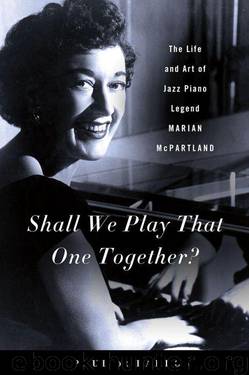Shall We Play That One Together?: The Life and Art of Jazz Piano Legend Marian McPartland by De Barros Paul

Author:De Barros, Paul [De Barros, Paul]
Language: eng
Format: epub
Publisher: St. Martin's Press
Published: 2012-10-15T21:00:00+00:00
12.
The Jazz Renaissance
(1973–1978)
THE “JAZZ RENAISSANCE” is usually said to have begun around 1976, but the music had begun to seep back into American soil early in the decade. Even while the marketplace turned its back, enterprising musicians kept jazz alive, releasing their own records, working in the schools (and in Europe), developing new markets, and remaining faithful to a loyal, if diminished, audience. By the end of the decade, jazz reemerged, albeit with a different identity. Marian, with her boundless energy, actually saw a rise in income between 1973 and 1978 and a steady heightening of her profile, buoyed by the jazz education movement and feminism. On the personal front, she and Jimmy fell into a comfortable new rhythm.
Marian was already a leading figure in jazz education, having headlined the first convention of the five-year-old National Association of Jazz Educators in Chicago, in 1973. As a spokesperson for the movement, she wrote a partisan feature for The New York Times about her work in the schools: “I Was Indignant That Rock Reigned Supreme.” In 1974, her bid to Nixon aide Len Garment bore fruit in the form of a $55,360 grant from the National Endowment for the Arts and the U.S. Department of Health, Education and Welfare to conduct demo/workshops in Washington, D.C., schools for nine weeks, staggered over several months. Billy Taylor, young trombonist Janice Robinson, saxophonist Andrew White, drummer Billy Hart, bassist Fred Williams, and—for one class—Jimmy and some of his pals taught in the program.
Most of Marian’s work in the schools had been with white middle-class kids, but the D.C. project took her to poor black neighborhoods. McPartland was appalled and depressed by the children’s ignorance of their musical history and their aggressive preference for disco over Duke. She was also unprepared for the noisy and physically restless black youngsters, their saturation by mass media and by music teachers, and local musicians openly hostile to her because a white person had been selected to teach black music. But, as always, she found new routes to the kids’ hearts. In one class, she demonstrated how Kool & the Gang’s “Jungle Boogie” was a reworking of rhythmic figures Louis Armstrong had pioneered a half century earlier and sparked their interest with the infectious, booming bass line of Herbie Hancock’s Headhunters hit “Chameleon.” The D.C. schools owned few musical instruments, but she made the best of what she had, bringing fifty kids onstage to ting and tang their “melody bells” (a small vibraharp used in the popular Kodály method) on Duke’s “C Jam Blues,” along with the United States Navy Band the Commodores, which she recruited to play a concert for thirty-five hundred students.
Marian discovered that the way she explained things sometimes went over the students’ heads. A teacher counseled her to ratchet down her vocabulary.
“I took so many things for granted, until Mary Taylor suggested going right to the beginning and explaining what a bar of music was,” Marian wrote. “Learning to describe musical procedures on such a basic
Download
This site does not store any files on its server. We only index and link to content provided by other sites. Please contact the content providers to delete copyright contents if any and email us, we'll remove relevant links or contents immediately.
The Goal (Off-Campus #4) by Elle Kennedy(13452)
Kathy Andrews Collection by Kathy Andrews(11705)
Diary of a Player by Brad Paisley(7455)
What Does This Button Do? by Bruce Dickinson(6120)
Assassin’s Fate by Robin Hobb(6099)
Big Little Lies by Liane Moriarty(5677)
Altered Sensations by David Pantalony(5027)
Pale Blue Dot by Carl Sagan(4883)
Sticky Fingers by Joe Hagan(4083)
The Death of the Heart by Elizabeth Bowen(3529)
The Heroin Diaries by Nikki Sixx(3475)
Beneath These Shadows by Meghan March(3247)
Confessions of a Video Vixen by Karrine Steffans(3228)
How Music Works by David Byrne(3151)
The Help by Kathryn Stockett(3066)
Jam by Jam (epub)(3003)
Harry Potter 4 - Harry Potter and The Goblet of Fire by J.K.Rowling(2967)
Strange Fascination: David Bowie: The Definitive Story by David Buckley(2780)
Petty: The Biography by Warren Zanes(2679)
